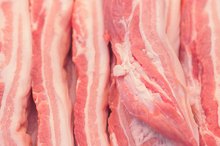What Is Fat Metabolism?
The metabolic break down of dietary fats supports many life-sustaining functions. Metabolized fat is stored as a reserve source of energy for use when needed. Fat provides insulation to keep your body warm; the fat beneath your skin is a source of heat when skin temperature drops. Fat cushions and protects your organs, and, in addition to your liver, fat provides storage for fat-soluble vitamins. The myelin sheath covering in your brain is also made up of 70 percent fat, according to Franklin Institute. Exercise and gender can affect the speed of fat metabolism.
Fat Energy
Fat, or adipose tissue, is your body's largest energy reserve, containing about 100,000 calories. Without additional food, fat can support metabolic functions for 30 to 40 days, according to Dr. Charles E. Ophardt, Professor Emeritus, Elmhurst College. However, water intake must be maintained. Fat molecules, as compared with carbohydrate molecules, contain little water. Based on this fact, Ophardt states, if glycogen, the storage form of carbohydrates, replaced fat stores in a 154-pound male, his body weight would increase by about 110 pounds because of the additional water weight.
- Fat, or adipose tissue, is your body's largest energy reserve, containing about 100,000 calories.
The Power Switch
Why Are Fats Important in a Diet?
Learn More
Dietary fat is broken down and stored in your fat cells as triglycerides, which are made up of three fatty acids and glycerol. Several chemicals help move stored fat out of adipose cells and into the blood stream for energy usage. Hormone sensitive lipase, found within the fat cell, and lipoprotein lipase are enzymes that help facilitate the release of fat with the help of the hormone epinephrine. This process is called lipolysis. When stimulated by epinephrine, HSL breaks down stored triglycerides and their components, three free fatty acids and glycerol, and releases them into the blood stream. Exercise enhances the response of HSL to epinephrine and increases fat burning. Obesity decreases HSLs response to epinephrine and slows fat metabolism, according to Len Kravitz, Ph.D., researcher and professor of exercise science at New Mexico University. LPL, found on blood vessel walls, controls how fat is distributed to its storage sites on your body.
- Dietary fat is broken down and stored in your fat cells as triglycerides, which are made up of three fatty acids and glycerol.
- Hormone sensitive lipase, found within the fat cell, and lipoprotein lipase are enzymes that help facilitate the release of fat with the help of the hormone epinephrine.
It’s a Sex Thing
According to Kravitz, gender plays a role in fat metabolism. Alpha and beta epinephrine receptors control fat release. Alpha receptors slow the release of stored fat; beta receptors trigger its release. Women have more alpha receptors in the hips and thighs than men do, and higher levels of LPL, the enzyme that controls fat distribution, in the hips, thighs and stomach area.
- According to Kravitz, gender plays a role in fat metabolism.
- Alpha receptors slow the release of stored fat; beta receptors trigger its release.
Boost Fat Metabolism
The Effect of Fat on Kidneys
Learn More
Obesity might cause an increase in the number of fat cells, known as hyperplastic obesity. Once fat cells develop, they may change in size as you lose or gain weight, but their number never decreases. You can avoid increasing the number of fat cells by keeping your body moving and practicing calorie control to increase fat metabolism. Consult your doctor or a dietitian, if you need help planning a healthy diet or to determine your specific daily calorie requirements based on your individual needs.
- Obesity might cause an increase in the number of fat cells, known as hyperplastic obesity.
- Once fat cells develop, they may change in size as you lose or gain weight, but their number never decreases.
Related Articles
References
Resources
Writer Bio
Sara Tomm began writing in 1971. She holds certificates in the medical, physiological and nutritional principles and treatment modalities for eating disorders. As a weight-management consultant, Tomm authored educational materials relating to the medical, psychological, environmental and social aspects of eating disorders, nutrition and physical fitness. She studied at Columbia University, Henry George School of Social Science, Farmingdale State College and Suffolk Community College.









